- Triceps kick-back / bent-over triceps extension
- Overhead extension / two-arms standing press
- Bent-over row / dead row
- Biceps curl
- Abdominal crunch
Introduction to weight training exercises
Resistance training (RT) has become an increasingly popular exercise for both males and females in gyms across Australia. RT can help to increase sporting performance through its beneficial effects on power, strength, flexibility, speed, health, body composition and fitness. RT is also an integral component of many rehabilitation programs and can aid in prevention of bone and muscle injury. RT can be used in multiple specialised age and disease groups in order to help prevent certain outcomes such as osteoporosis (brittle bones).
 |
For more information on this form of physical activity, see Resistance Training. |
This page contains a number of common resistance training exercises that are used to work the major muscle groups. For all the following exercises the motions should be smooth and continuous. Accordingly the joints involved in the muscle contractions should not lock at any stage of the exercise or while carrying the weights. At all times the core muscles; including hips, pelvis, lower back and stomach, should be stable and tightened in order to protect the spine. Remember to always bend the knees when picking up any weight.
You should not begin resistance training without first speaking to your doctor. You should also obtain feedback from a qualified sports professional to ensure you are following proper technique.
Squat
The squat works the:
- Quadriceps (front of thigh);
- Hamstrings (back of thigh);
- Glutes (bottom); and
- Lower Back
The bar should be placed on the shoulders behind the head, the “meaty” part of the neck. Hands should be spaced more than shoulder width apart on the bar, with your wrist to your elbows in a straight line. The legs should be hip distance apart or slightly more. The squat involves a bend through the knees, hips and ankles in a “sitting” motion, so thighs squat parallel to the floor. The spine should be stable and not bend at all throughout the exercise. During squats all the weight should be in the heels. The knee bend should reach close to a 90 degree angle, but no more. When the set is finished knees must be bent when placing the bar down.
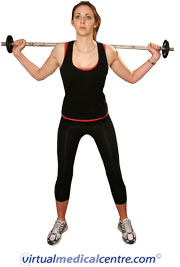 |
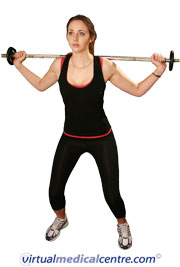 |
 |
Bench press
The bench press works the:
- Chest;
- Shoulders; and
- Triceps (back of arm).
Begin the bench press by lying flat on back with abdominal muscles pulled down as though attempting to draw the navel toward the bench. Knees should be bent and placed on the floor and the head relaxed in a neutral position on the bench. The bar should be gripped wide with knuckles pointed toward the ceiling and the elbows in a 90 degree angle. Elbows should never dip below the level of the chest. The bar should sit directly on the nipple line, approximately 5 cm from the chest. The bar should be raised vertically until the elbows are straight but not locked in position and then return back down to just above the chest. The client should feel tension in their chest muscles and not their shoulder or back muscles, the back should never arch.
When a heavy weight is used it is highly recommended that a spotter is present to avoid potential injury.
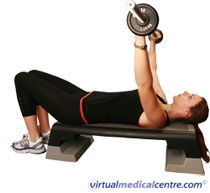 |
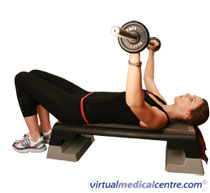 |
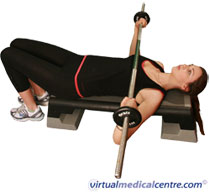 |
Dead lift
The dead lift works the:
- Back; and
- Hamstrings (back of the thighs).
While keeping eyes focussed straight ahead, bend knees and pick up the bar. Feet should be hip-width or slightly wider apart. Hands should grip the bar just on the outside of the hips with straight arms, not locked at the elbow joint. With knees bent at a constant angle and back kept straight, bend at the hips until the bar is lowered to the knees then extend the hips bringing the bar back to the starting position.
The lower back should not flex (bend) at anytime, the hip extensors should perform the majority of the exercise.
 |
 |
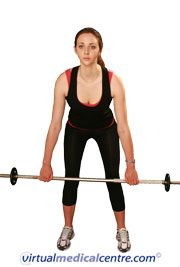 |
Lunge
The lunge works the:
- Quadriceps;
- Hamstrings;
- Glutes;
- Calf (back of foreleg) and
- Lower back.
A lunge can be done with or without weights. If using a barbell, place it on the meaty part of the neck. To begin a lunge both legs should be split parallel to one another, one foot in front of the body and one behind, feet hip width apart. The stance should be wide enough so as both knees can bend they can reach a 90 degree angle, but no more. To test this, the front knee should not push past the level of the shoe laces at any stage of the lunge. Make sure knees remain stable and do not roll and that the back remains upright in a neutral position.
 |
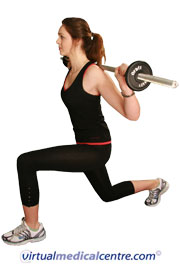 |
Triceps dip
Triceps dips target the:
- Triceps (back of the arm)
Hands should support the body off the edge of a bench or step. Knuckles pointing forward and buttocks close to the edge of the bench. Elbows should be bent backwards until they reach the level of the shoulders but no further; the body is lowered toward the ground and pushed back up again by squeezing the triceps. The further the feet rest on the floor in front of the bench the more intense the workout will be.
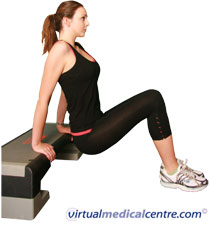 |
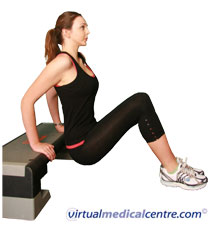 |
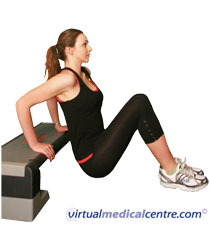 |
Triceps kick-back / bent-over triceps extension
The triceps kickback works the:
- Triceps
Set up the triceps kickback with hands directly under the shoulder blades and feet directly below the knees, one arm then needs to support the front of the body while the other holds a free weight. The working arm needs to be held directly backward toward the hips with a rigid wrist to support the weight. The elbow needs to stay very close to the body as it gently bends; the weight should be brought to the leg line only and back up again, squeezing the triceps. Shoulders and hips should be level with one another. Head should look slightly forward.
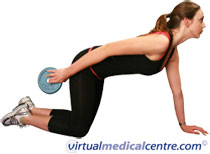 |
 |
Overhead extension / two-arm standing press
The overhead extension works:
- Shoulders; and
- Triceps.
The hands should grip the bar shoulder width apart and held just slightly above the chest. The bar is then slowly raised in a controlled movement, moving backward slightly as it is raised so that it stops in line with the body’s centre of gravity; just above the head. Ensure that it does not go back past the head. The elbows should be fully extended but not locked in position. The bar is then returned to the starting position. The back needs to be kept straight and not lean backward at all times and the wrists should not extend backwards.
 |
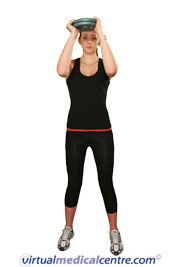 |
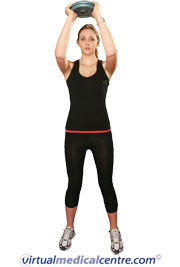 |
Bent-over row / dead row
The bent-over row targets the:
- Upper back;
- Back of shoulder;
- Biceps (front of arm) and
- Back of forearm.
While keeping eyes focussed straight ahead, bend knees and pick up the bar. Feet should be hip-width or slightly wider apart. With knees bent at a constant angle, back straight and abdominal muscles pulled in, squeeze the shoulder blades together. The bar should move up toward the chest and reach the level of the stomach. Using a controlled movement the bar should then be lowered back to the level of the knees. The arms should remain close to the body throughout the exercise.
 |
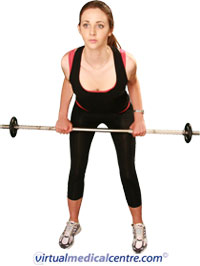 |
Biceps curl
The biceps curl targets the:
- Biceps; and
- Front and back of forearm
Eyes should be focussed straight ahead and hips shoulder width apart. Bend knees and pick up the bar with palms facing forward. Stand up straight with hands gripping the bar just next to the hips and elbows fully extended. Contract the biceps as the elbows bend and the bar is pulled upwards toward the chest, this is the concentric movement. Using a controlled movement the bar should then be lowered again to the starting position, this is the eccentric movement.
Do not use the back for momentum to pull the bar upward. The back should remain stable at all times, to ensure this it may help to stand against a wall.
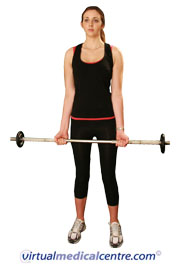 |
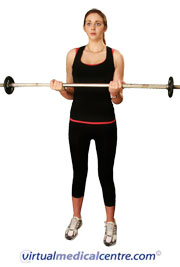 |
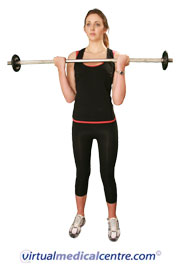 |
Abdominal crunch
The crunch works the:
- Abdominal (stomach) muscles.
Begin by lying on back on the floor with feet placed close to the bottom. Tightly contract abdominal muscles ensuring the lower back does not lift from the ground. Using the strength of the abdominal muscles slowly pull the upper body off the ground. To avoid using arms as momentum place them across the chest or on the hips. For extra neck support hands can be placed behind the head but should not be used to heave the upper body off the floor. No neck pain should be felt if the exercise is done correctly.
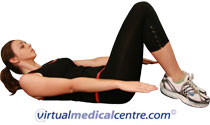 |
 |
References
- Rasch PJ. Weight Training 5th Ed. WCB: Dubuque, Iowa; 1990.
- Lombardi VP. Beginning Weight Training. McGraw Hill: Texas; 1989.
- Kennedy R. Natural Body Building For Everyone. Sterling Publishing Co., Inc: New York; 1981.
- Thompson CW, Floyd RT. Manual of Structural Kinesiology. 14th Ed. McGraw Hill: New York; 2001.
All content and media on the HealthEngine Blog is created and published online for informational purposes only. It is not intended to be a substitute for professional medical advice and should not be relied on as health or personal advice. Always seek the guidance of your doctor or other qualified health professional with any questions you may have regarding your health or a medical condition. Never disregard the advice of a medical professional, or delay in seeking it because of something you have read on this Website. If you think you may have a medical emergency, call your doctor, go to the nearest hospital emergency department, or call the emergency services immediately.







